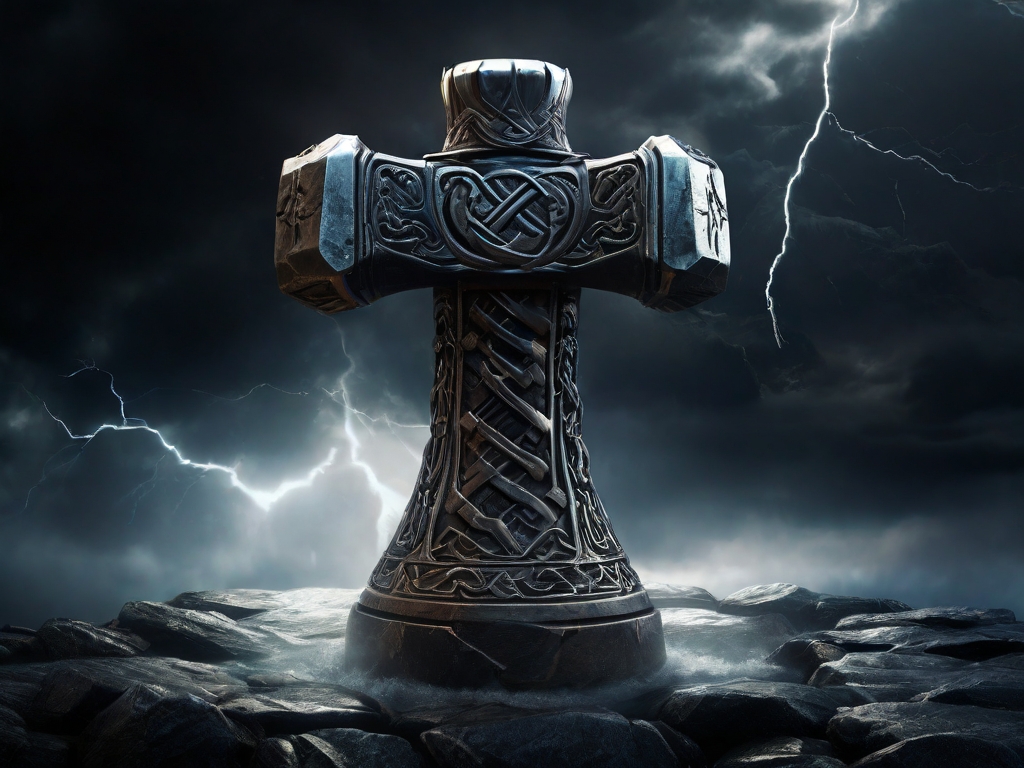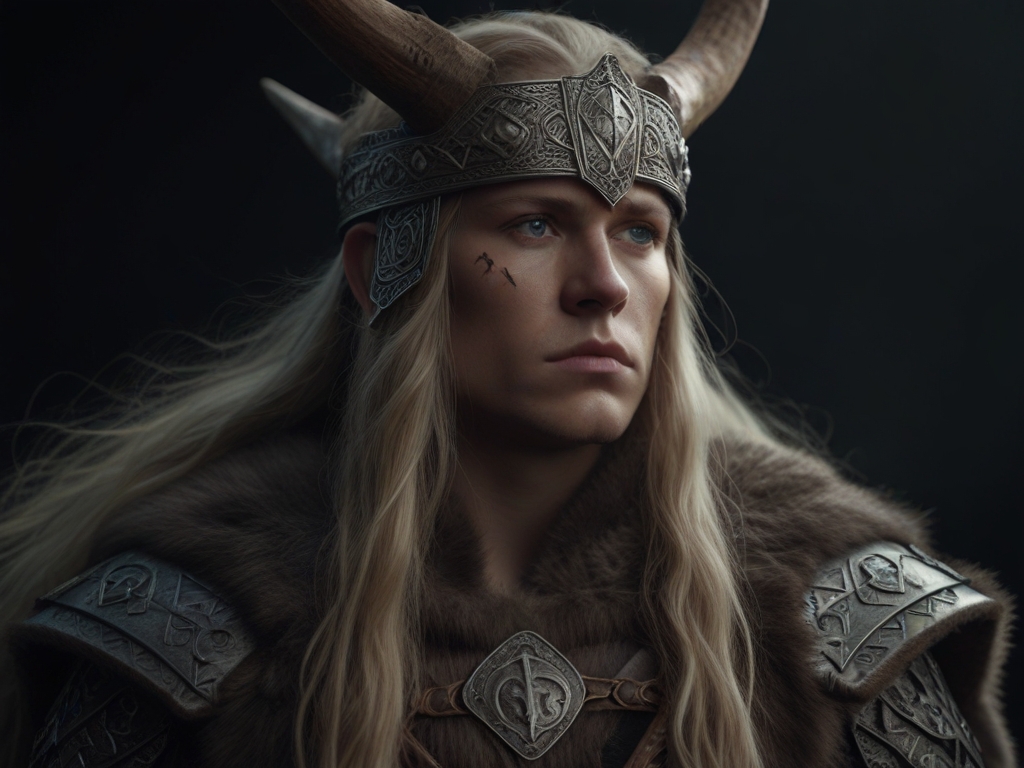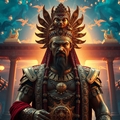Welcome to the fascinating world of Norse mythology! Norse mythology is a rich and diverse universe filled with exciting gods, heroes and mystical beings that embody the power of nature and the depths of human experience. These images present the most important figures, creatures and locations of mythology, while guiding us through the endless wonder and mysteries of the world. Let's explore this exciting and inspiring world together and immerse ourselves in the magical world of Nordic mythology!

Odin is known as the chief god of gods in Norse mythology. He is the king of the gods and the lord of life and death. God of wisdom, war and magic. His throne, Valhall, is the home of the heroic dead, where loyal warriors await their rebirth after Ragnarök.

Hugin and Munin
Hugin and Munin are Odin's two ravens who fly away every day to bring back news from the world of the gods. Their names mean "thought" and "memory" and they help Odin gather information and gain wisdom about world events.

Thor
God of storm and lightning and protector of people. With his mighty hammer, Mjölnir, he creates a storm and defeats his opponents. Among other things, he is one of the most well-known and popular gods of Nordic mythology.

Mjölnir is the hammer of Thor, god of storm and lightning in Norse mythology. This powerful weapon gives Thor power and protection and is often used in combat and defense.

Jord is the Earth Mother, who is the mother of Thor and the guardian of the earth. He takes care of the protection of nature and animals and has great power over life and nature.

Loki
The trickster god who often causes chaos and trouble among the gods. Often referred to as the god of contradictions, he goes through many adventures that often create tension between gods and humans.

Fenrir is one of the most feared creatures in Norse mythology. He is the child of Loki and Angrboda and is depicted as a huge, fearsome wolf. During Ragnarök, he is freed from his chains and plunges the gods into great danger.

Yggdrasil, the world three
The central tree of the universe that connects the nine worlds. This tree is a symbol of life, death, and rebirth, and represents power over all in the world of mythology.

Heimdall
Guardian of the End of the World, standing guard over the Bifrost Bridge and watching over the worlds of gods and men. He has extraordinary senses and strength and fights the fire giants during Ragnarök.

The Bifrost Bridge is a sort of gateway between gods and humans, through which gods can travel to protect or help humans. It also plays an important role during Ragnarök as the scene of the final battle between gods and monsters. Based on the descriptions, this bridge is truly an impressive sight and has become one of the most iconic symbols of Norse mythology.

Freya
The goddess of love, beauty and fertility. She is one of the most important goddesses and is often held in the highest respect among the gods.
 Brisingamen is a jewel in Norse mythology owned by the goddess Freyja. This beautiful necklace represents power and beauty in Norse mythology and is often seen as a symbol of love and desire.
Brisingamen is a jewel in Norse mythology owned by the goddess Freyja. This beautiful necklace represents power and beauty in Norse mythology and is often seen as a symbol of love and desire.

Freyr
God of fertility and wealth. She oversees the abundance of nature and the fertility of the fields, and is often depicted sitting peacefully in her golden robes.

Surt is a fire giant in Norse mythology who burns the world at the end of Ragnarök. He is the lord of Muspelheim, the realm of fire, and he brings great flames with him to destroy the world.

Balder
God of light and harmony. He is one of the most beloved gods, whose beauty and benevolence touched everyone. However, he also falls during Ragnarök, which is a sad fate for the gods and the world.

Frigg
Wife of Odin, goddess of motherhood and marriage. As a mother figure, she looks after both humans and gods and plays an important role in many myths.

Tyr God of justice and warfare. He is one of the primary gods who faithfully serves the gods and fights bravely for justice.

Hel
Lord of the underworld, where the souls of the dead reside. His name also refers to his realm called Helheim, where he rules.

Helheim is the underworld where the souls of the dead reside. Hel, the lord of the underworld, maintains his rule here and welcomes those people who do not end up in the realm of the gods or the warrior's paradise, Valhalla.

Valhall is the home of the heroic dead in Norse mythology. Odin, the god of war and wisdom, gathers here the souls of warriors who have proven themselves worthy of a heroic death in battle. Valhall is a place of eternal joy, combat training and solace for warriors.

Njord
He is the god of the sea and fishing, as well as the god of wealth and peace. It is often associated with sea voyages and success in maritime trade.

Sif
Goddess of fertility and agriculture and wife of Thor. Her long golden hair is a natural symbol of autumn grain.

Idun
Guardian of the apples of youth and eternity. With the help of the apples, the gods obtain eternal youth and vitality, and Idun is responsible for ensuring that no one else marries them.

Skadi
Goddess of snow and hunting. Often associated with winter and cold, he leads massive hunts against snow leopards and other snow-related creatures.

Ymir
The first giant born in the early stages of the creation of the universe. The world is created from his body, and he is the arch-enemy of the gods.

Bragi
He is the god of poetry and wisdom, as well as the patron of singing and melodies. It bravely represents the values of art and culture in many myths.

Vidar
In Nordic mythology, Vidar is one of the divine warriors who survives the apocalyptic battle after Ragnarök. He will be one of the new gods who will rebuild the world after its destruction.

Eir
Goddess of health and healing. He is responsible for healing the sick and wounded and helps with natural remedies and the use of herbs.

Norns are goddesses of fate who oversee the fate of the world and the fate of all humans. They decide the length of people's lives and bind the destinies of people and gods.





